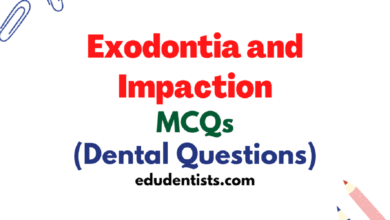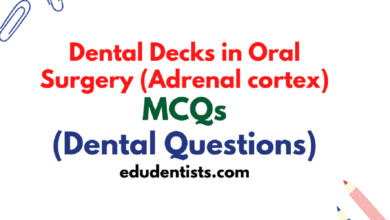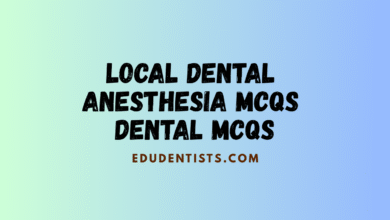Oral and Maxillofacial Surgery MCQs
Hypertension & Dental Management MCQs
Hypertension & Dental Management MCQs

Hypertension & Dental Management MCQs
Hypertension & Dental Management MCQs
Basic Understanding
- What is the minimum systolic pressure that defines hypertension?
A. 120 mm Hg
B. 130 mm Hg
C. 140 mm Hg
D. 150 mm Hg - Diastolic pressure during heart filling is measured as:
A. Pulse pressure
B. Diastolic BP
C. Systolic BP
D. Mean arterial pressure - Which of the following conditions is NOT directly associated with hypertension?
A. Stroke
B. Asthma
C. Heart failure
D. Renal failure - Prehypertension is defined as:
A. <120/<80 mm Hg
B. 120–139/80–89 mm Hg
C. 140–159/90–99 mm Hg
D. ≥160/≥100 mm Hg - Stage 2 Hypertension classification starts from:
A. 140/90 mm Hg
B. 120/80 mm Hg
C. ≥160/≥100 mm Hg
D. <180/<110 mm Hg
Signs, Symptoms, and Risk Factors
- Which is an early sign of hypertensive disease?
A. Proteinuria
B. Papilledema
C. Elevated BP readings
D. Dementia - Advanced hypertensive symptoms include all EXCEPT:
A. Retinal hemorrhage
B. Congestive heart failure
C. Headache
D. Dementia - Which of the following is a modifiable risk factor for hypertension?
A. Age
B. Smoking
C. Family history
D. Ethnicity - Which hormone from kidneys increases BP by retaining fluid?
A. Insulin
B. Vasopressin
C. Renin
D. Cortisol - Atherosclerosis increases BP by:
A. Enhancing kidney filtration
B. Narrowing vascular lumen
C. Dilating blood vessels
D. Decreasing cardiac output
Dental Considerations
- Elective dental care should be deferred if BP is:
A. 160/90 mm Hg
B. 140/90 mm Hg
C. ≥180/110 mm Hg
D. ≤120/80 mm Hg - The best approach to lower white coat hypertension in clinic is:
A. Increase BP medications
B. Use steroids
C. Use nitrous oxide sedation
D. Give antibiotics - NSAIDs should be used with caution in hypertensive patients because they:
A. Increase glucose
B. May reduce antihypertensive effect
C. Interact with insulin
D. Increase bleeding risk - For dental procedures, how much epinephrine is safe in a stable hypertensive patient?
A. 4 cartridges
B. None
C. 2 cartridges of 1:100,000
D. 3 mL - Which oral side effect is most common with antihypertensive drugs?
A. Halitosis
B. Dry mouth
C. Staining
D. Gingival overgrowth
Pharmacologic Management
- Which class of antihypertensive drugs may cause lichenoid reactions and taste changes?
A. Diuretics
B. ACE inhibitors
C. Beta blockers
D. Calcium channel blockers - Which of these is a thiazide diuretic?
A. Amiloride
B. Hydrochlorothiazide
C. Furosemide
D. Triamterene - Which drug class should be avoided with erythromycin due to hypotensive risk?
A. Beta blockers
B. Calcium channel blockers
C. ACE inhibitors
D. Diuretics - Which drug causes angioedema as a side effect?
A. Spironolactone
B. Metoprolol
C. Lisinopril
D. Furosemide - Loop diuretics include all EXCEPT:
A. Bumetanide
B. Furosemide
C. Hydrochlorothiazide
D. Torsemide
Clinical and Chairside Management
- When should BP be rechecked if patient’s BP is normal?
A. Next week
B. In 2 years
C. Every visit
D. Monthly - For patients with 160/100 mm Hg BP, the dental plan includes:
A. Immediate referral
B. Avoid treatment
C. Monitor and refer within 1 month
D. Prescribe antibiotics - What is the best position change protocol to avoid orthostatic hypotension?
A. Slowly raise the chair upright
B. Quickly sit the patient up
C. Place in Trendelenburg
D. Lower feet first - An antihypertensive that is potassium-sparing:
A. Indapamide
B. Amiloride
C. Bumetanide
D. Metoprolol - In hypertension, the safest vasoconstrictor in local anesthesia is:
A. Epinephrine 1:100,000
B. Phenylephrine
C. Levonordefrin
D. Norepinephrine
Dental Drug Interactions & Risk
- Which antihypertensive class causes angioedema and oral burning?
A. Diuretics
B. ACE inhibitors
C. Beta blockers
D. ARBs - Why should levonordefrin be avoided in hypertensive patients?
A. Reduces analgesia
B. Raises BP significantly
C. Induces sedation
D. Causes dry mouth - Which device may be affected by ultrasonic scaling but is generally safe today?
A. Pacemaker
B. Insulin pump
C. Oxygen monitor
D. Nebulizer - Which of the following is least likely a dental complication of hypertension?
A. Anxiety
B. Encephalopathy
C. Excess bleeding
D. Orthostatic hypotension - Which class is recommended first for Stage 1 hypertension without comorbidities?
A. ACEIs
B. ARBs
C. Thiazide diuretics
D. Beta-blockers
Diagnosis, Classification, and Devices
- What defines “prehypertension”?
A. >160/100
B. <120/80
C. 120–139/80–89
D. >140/90 - What BP range permits dental treatment but requires physician referral?
A. <120/80
B. ≥180/110
C. 140–159/90–99
D. >160/110 - Which drug is a cardioselective beta-blocker?
A. Atenolol
B. Propranolol
C. Pindolol
D. Nadolol - Which hypertensive drug works by blocking aldosterone?
A. Lisinopril
B. Spironolactone
C. Metoprolol
D. Furosemide - ICDs are primarily used for:
A. Controlling BP
B. Managing tachyarrhythmias
C. Reducing fluid retention
D. Inducing sedation
Advanced Application
- Dental patients with HF may have which device implanted?
A. Glucose monitor
B. Pacemaker/ICD
C. Dental implant
D. EEG - Which hypertensive drug does NOT interact with vasoconstrictors?
A. Propranolol
B. Pindolol
C. Thiazide diuretics
D. Nadolol - Which condition is NOT associated with long-standing hypertension?
A. Angina
B. Anemia
C. Papilledema
D. Retinopathy - Which sedative method is preferred for managing hypertensive dental anxiety?
A. Intravenous morphine
B. Oral or inhalation sedation
C. Ketamine IM
D. Barbiturates - Main goal of antihypertensive dental care is to:
A. Cure hypertension
B. Replace medications
C. Prevent complications during dental treatment
D. Adjust pacemaker settings





